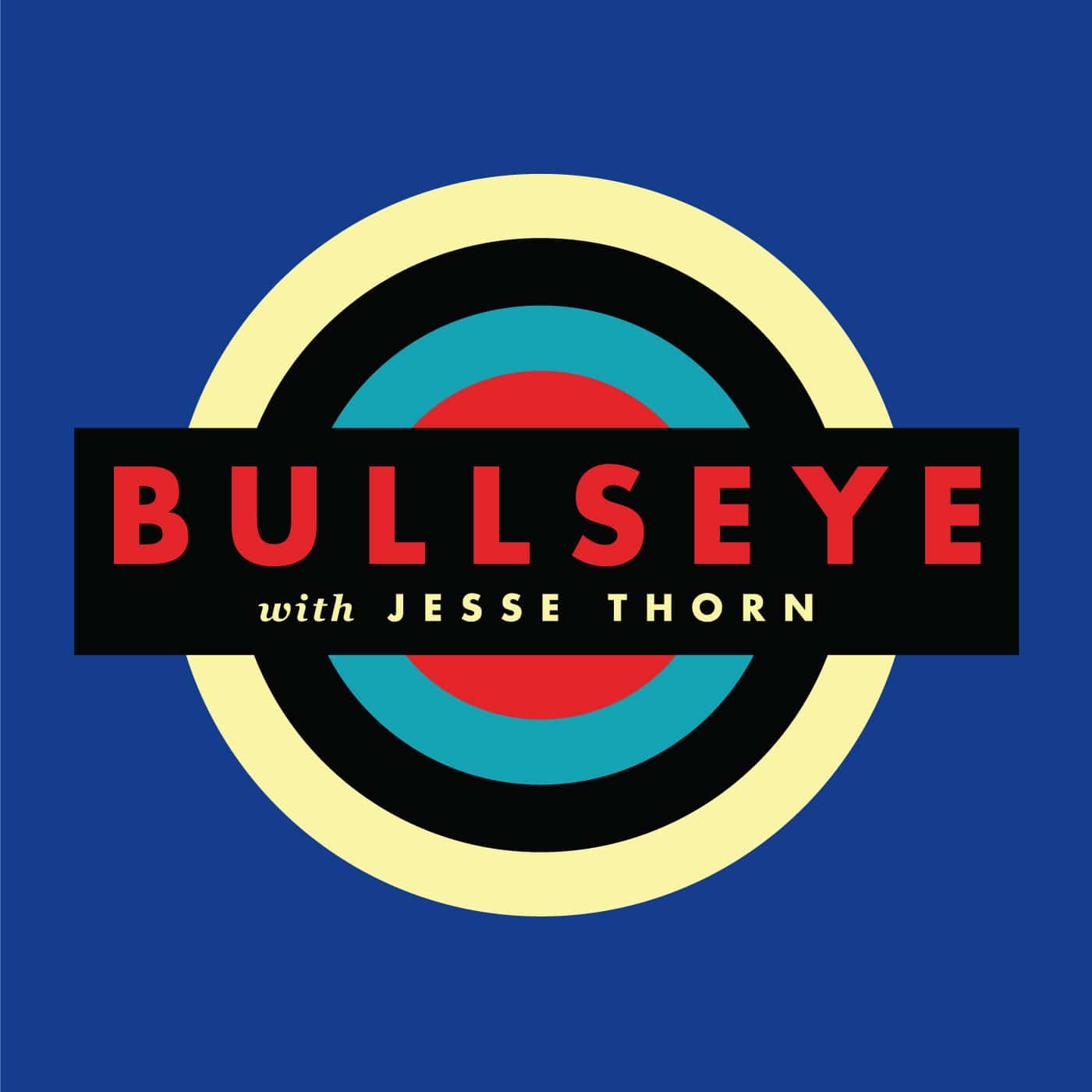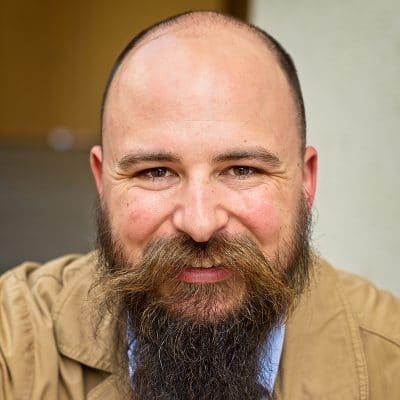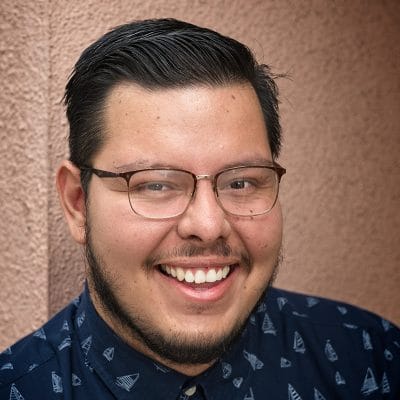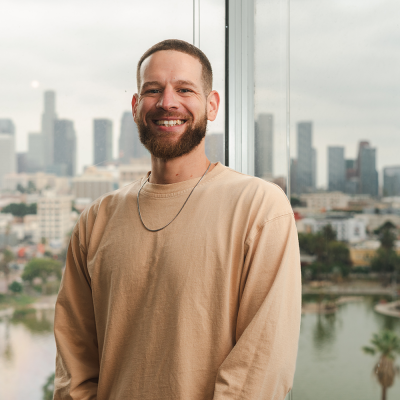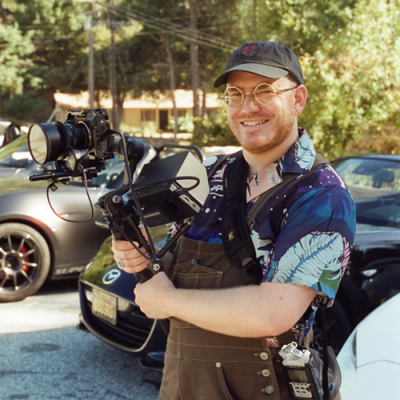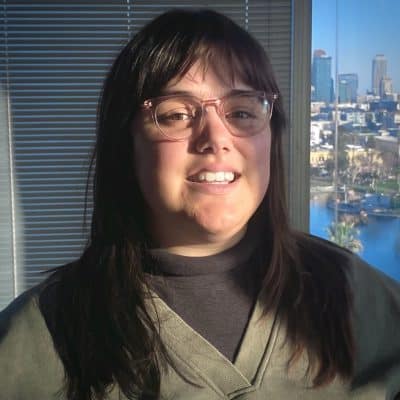Transcript

music
Gentle, trilling music with a steady drumbeat plays under the dialogue.

promo
Speaker: Bullseye with Jesse Thorn is a production of MaximumFun.org and is distributed by NPR. [Music fades out.]

music
“Huddle Formation” from the album Thunder, Lightning, Strike by The Go! Team.

jesse thorn
It’s Bullseye. I’m Jesse Thorn. A quick warning before we get into this interview: the conversation you’re about to hear is about medical history, so we will be talking about blood and guts and injuries and other potentially squeamish stuff. So, if you’re sensitive to that, we thought we’d let you know. Anyway. There’s something fascinating and morbid about medical history. Something that is unique to that genre. Like, if you read up on military history, odds are you’ll hear a lot about generals maneuvering soldiers around, surprising each other, burning down cities. The technology has changed, but nothing else has, really. We’ve always known how to fight war. But if you look into the history of medicine, one thing will become very clear very quickly: for a very, very, very long time we had no idea how our own bodies work. Sawbones, which is a podcast produced here at Maximum Fun, is a show about all the gruesome, gross, and sometimes very funny stuff that we did to our bodies in the name of health and medicine. It’s hosted by Dr. Sydnee McElroy--a physician and medical history buff—and her husband Justin McElroy—who hosts the shows My Brother, My Brother, and Me and The Adventure Zone. Since the COVID-19 pandemic has dominated the headlines, Sawbones has also become a great source for reliable context and information about vaccines, epidemiology, and why you shouldn’t take your dog’s worm medicine to fight off the coronavirus. When Sydnee, Justin, and I talked in 2018, they’d just released a book based on the show. It’s called The Sawbones Book: The Hilarious, Horrifying Road to Modern Medicine. It is beautifully illustrated by Teylor Smirl. And just a couple months ago, the book got a paperback edition—a definitive paperback edition with new material. You can buy it now, too. Anyway, let’s get into it. Justin and Sydnee McElroy of Sawbones.

music
Thumpy, relaxed music.

jesse
Dr. Sydnee McElroy, Justin McElroy, welcome to Bullseye! It’s nice to talk to you guys!

justin mcelroy
What an honor it is to be on your program finally, Jesse, as an auteur. [Jesse laughs.] Which is what us authors call authors.

jesse
[Laughing.] Really?

sydnee mcelroy
Is that what—is that what we say?

justin
Yes, that is what us authors—or auteurs, if we prefer, say. [Jesse giggles.]

sydnee
I didn’t get that memo.

jesse
So, you two were podcasting before you started Sawbones. You had two television podcasts, which is a much more typical thing to podcast about. How did you end up podcasting about the very specific topic of medical history?

justin
[Snorts with restrained laughter.] Sydnee always gets mad at me because in interviews, I always bring up these two great shows—these great concept shows.

sydnee
They weren’t great. [Jesse laughs.]

justin
The first was called—

sydnee
Go ahead. I—I—go ahead. I didn’t agree to this.

justin
Losing the Sheen, which was a—darn, that’s like the punchline, but the setup is it’s a show about Two and a Half Men hosted by two people that did not watch it until Ashton Kutcher joined the show and replaced Charlie Sheen. And it was a episode-by-episode recap that we managed to stick with for all of… ten episodes, I think. Nine or ten episodes on Losing the Sheen before we were like, “Hey, this is—there’s no amount of like—"

sydnee
This is soul-crushing.

justin
Yeah, it’s soul-crushing. It’s soul-crushing. And then we decided to do a general TV podcast called Satellite Dish and that was pretty good, except it made it so that we had to watch more TV than we wanted to keep up with, like, the demand of having a TV podcast.

sydnee
Yeah, we got—and we just got too busy and so we started to think, “Doing a podcast is fun, but how can we kind of capitalize on what I was doing with the majority of my time?” Which was acting [beat]—you know—as a physician. Being a doctor. And so—

justin
She’s a real physician. She wasn’t acting like—

sydnee
Yeah, not just acting.

justin
Not in like—not in a—not in a Catch Me if You Can situation. [Jesse and Sydnee laugh.]

sydnee
So, I’d always been interested in medical history. It was something that I, for fun—if that is fun—would read about in my spare time. And so, we started talking about how some of these stories are pretty funny and kinda gruesome and pretty wild and maybe other people would like to hear them and Sawbones was born.

jesse
Sydnee, why do you think you were interested in medical history? Even as a doctor, I’m sure many of your colleagues are glad to know the latest and greatest and not worry about Pliny the Elder.

sydnee
[Laughs.] Part of it is some of the conclusions we’ve come to and the ways that we manage things, it’s just fascinating to think about, “How did we figure that out? How did we get here? How did we come up with that?” And that was part of why I wanted to know and then the other thing about medicine is that so much stuff has eponyms. You learn about, you know, various signs that are named for different doctors or places or patients or whatever. And I was always curious as to, “Who was that and what did they do and why did they get that named after them and how do I get that?” And—[chuckles].

justin
It was also a way for us to avoid giving advice, which can get legally a little dicey. [Sydnee agrees.] And just morally and ethically, like, challenging. So, talking about what people used to do helps us to skirt that really handily.

jesse
[Laughs.] I like that you’re controlling liability with this podcast.

justin
That was the first—that was the original title, but we just couldn’t fit it on the thumbnail.

jesse
So, can you take me kind of briefly, Sydnee, through the basic history of what people—and particularly in what used to be called “the west”—knew about how the body worked up until the 20th century? Like, when did we figure out that hearts are important or that brains are for thinking? [Sydnee laughs.]

justin
So, we’ll just sum up the past 245 episodes of our podcast in a breezy two-minute summary, no problem at all. Sydnee, go! All of medical history in two minutes! [Giggles.]

jesse
[Helplessly.] I’m just looking for a few basic signposts I can build the rest of this around, okay?!

sydnee
Um, a lot of the first challenge is anatomy. I mean, that was—that was the basic first challenge, was, “What’s inside the human body and can we take a look and figure that out?” And it really wasn’t until dissection started becoming culturally and socially acceptable and that was during the medieval period, actually, when we started to see more dissections and we got a better understanding of anatomy. Up until then, a lot of it had been derived from a couple people who had done dissections here and there and written about it and then a lot of animal dissections. And so, we had a lot of weird ideas about what was going on in there. So, that was probably the first turning point was when we could actually start doing dissections and then we knew what the pieces were. It—a lot of it, from there forward until we get to—gosh, the 1800s. The humoral system of medicine was still popular up until then. The idea that we have four humors and we’ve gotta balance them. We were still debating did veins and arteries carry blood or air or—we had weird ideas like maybe our bones are made of semen. Uhh. [Jesse chuckles.] All of these things until—[laughs].

justin
Jury is still out on that one, by the way. Science is going back and forth still.

sydnee
Really it’s not until the 1800s that we start to get a firmer idea of what each organ does and where different processes take place and then medical science really explodes at the turn of the century, there. And throughout the 1900s. I mean, it’s just advance after advance and the germ theory of disease and then we understand, you know, how we can infect each other with various illnesses and then vaccines and antibiotics come along and everything changes throughout the first half, really, of the 1900s.

justin
Well, and also you have a huge shift in the idea of, like, what science can do. Because we didn’t understand any of these things before we started applying treatments. So, like, even back before we would understand why something would work or something wouldn’t work, it was just about, “Well, I don’t know. Let’s try it and let’s record the phenomena and see what happens and see what the effect of this thing is. And that is our role. And it’s not to understand why things are working, it is just to catalogue what does and does not work.” So, we’re trying treatments a long, long, long, long, long time before we ever have the understanding to create a reasonable hypothesis for why these things work.

sydnee
And to differentiate between correlation and causation was a big deal. [Justin agrees.] There were a lot of, “Well, your hiccups stopped after you walked through a crossroads. So, walking through a crossroads must stop hiccups.”

justin
Hiccups is actually, I think, the best, number one—like, if you wanna understand medical history, I’m obsessed with the idea of hiccups, because hiccups and I think warts are the two where I would put it, like—throughout all of human history, we have had hiccups and then stopped having them at a certain point after that. [Jesse chuckles.] And whatever you did right before that moment was the cure for hiccups. [Sydnee agrees.] That’s why there’s no consistent—like, you hear a hundred different cures for hiccups and it’s all because we just believed, “Well, whatever we did right before they stopped, that’s the cure. That’s what did it. That works.”

jesse
Sydnee, you both teach medicine and are a family doctor. Has thinking about these things affected the way that you practice?

sydnee
I think for sure. I’m a lot more in tune with the fact that even though we have come very far, and we know a lot more than we used to—even 50 years ago—there’s still a lot we have to learn. There is still a reason to take every new advance and look at it and analyze the data and figure out why we’re making these decisions and then take all that and still try to advise. There is still some individual treatment for each patient. There’s still a way to take all that evidence and then use the part of it that is most appropriate for each person for their health and for their benefit. And I think I’ve really—I’ve really come to understand that better from studying this. And I feel a lot luckier [chuckles] to be practicing medicine now than I would 100 years ago.

jesse
I mean, I think about that all the time. I have a chronic health condition. I have severe migraine headaches. And I think of the fact that, you know, human beings have been on the earth for sooo long. Like, sooo long. And my health condition doesn’t threaten to kill me, but it sure makes my life miserable. And I think what an incredible difference just the past 25 years, even since—in my memory is, over the 25 years before that when my mother suffered from migraines. To say nothing of 75 years ago when my grandmother suffered from migraines or 100 years ago when some guy in Dusseldorf just, you know, would try to self-trepanate so he could let the demons out or whatever. [They chuckle.]

sydnee
Uh-huh. No, it’s very true. I think I’ve become—I hope—a better advocate for, like, vaccination—as an example—because of this, when I’m talking to my patients, people who are nervous about it. I think having the historical perspective and saying, “Listen. I know. I know how hard it is to see your kid get a shot but let me just walk you through why and how and what it was like before.” Having that perspective of what it was like 25, 50, 75, 100 years ago and the dangers that were out there for kids. I—I think it—I hope it helps me be a better advocate.

justin
It’s also been one of the frustrating things about making Sawbones in the past couple of years, is that what started out as a show that was supposed to be about medical history and, “Hey, hooray for us. Aren’t we smart? We solved all these things.” Far too frequently, I think, our show has had—recently—has had to become like, “Hey… this is still true. [Chuckles.] These things are still made up. Like, there is still such a thing as right and wrong and true and false and some people still would love to steal your money to pretend to make you feel better. Or just get asbestos back out there!” [Sydnee and Jesse laugh.] “Get its moment to shine again! Nope! Still bad! It’s still actually very bad for you!” Is actually one of the things that is still very true. So, that kind of stuff has gotten—it has, like, inadvertently made Sawbones more political just because, like, [laughs] talking about how science is an actual thing has become annoyingly—

sydnee
Has become a political act. Yeah. [Justin agrees.]

jesse
Sydnee, it must be interesting for you to be constantly engaged with the failures of your profession.

sydnee
Mm-hm. Uhh, that’s definitely true. I mean, it’s a good way to stay humble, which I think is absolutely critical in the medical profession. The human body and medical science and how much we don’t know, it’s—it should be incredibly humbling. And I think if you come at taking care of people from that perspective, then you will do your best job and know your limitations. I think it’s really important, as a physician, to be able to say, “I don’t know,” and just honestly tell a patient that. And that’s very hard. That’s an incredibly difficult thing, when you’re in the room and somebody’s looking to you for answers and you don’t have an answer, ‘cause either we don’t know yet or that’s something—I’m gonna have to read about that, ‘cause that’s not something I come across every day, and so I need to do more research. Oh man, it’s hard to say, “I don’t know.” And I think knowing that a lot of people before me have either had to say, “I don’t know,” or didn’t and… uhh, you know, they paid the—paid the price for that. I think it’s good.

justin
I think—I think it’s hard, also, because I think to hear you talk about it, Syd, it is hard to say, “I don’t know, but also the internet does not also know, so please don’t go ask the internet. ‘Cause the internet does not know better.” And I think that’s the assumption is the doctor—there’s this presupposition people make on the internet all the time about medicine or doctors that doctors are trying to keep the good stuff from people. So, like, an admission of ignorance from a doctor can, like—the internet can rush in to fill that vacuum. And I think that can be really dangerous.

sydnee
It is. And that’s actually one of the things that I have said, and I’ve heard my colleagues say a lot, is that I wish I had the kind of self-assuredness or confidence that some of the people who are out there peddling fake cures and fake medicine have. Because if you—if you watch, like, people on the internet doing, like, nutritional response testing, they are so certain. And that is a certainty that a lot of the time I just can’t have, because I think this is right. I have the evidence. This should be—this should work for you. But everybody’s different and everything is—every day is different and so let’s try it and then come back and let’s see how it goes. Somebody with that kind of certainty always makes me a little wary.

jesse
We’ll wrap up my conversation with Sydnee and Justin McElroy when we return from a break. Still to come: imagine if we could get one of those old-timey doctors into a time machine and transport them to today. How would they react to modern medicine? The Sawbones team has a pretty good guess. It’s Bullseye, from MaximumFun.org and NPR.

promo
Music: Inspiring music throughout. ## [The “testimonials” cut between different VOs. They are not talking to one another.] ## Speaker 1: I started listening to Oh No, Ross and Carrie! shortly after I broke my arm. ## Speaker 2: I was... allergic to water. I knew it was time to make a change. ## [Music swells hopefully to a dramatic crescendo] ## Speaker 3: There’s something about Oh No, Ross and Carrie! that you just can’t get anywhere else. ## Speaker 1: They’re thought-leaders, discoverers, founders. ## Speaker 2: Healers. ## Speaker 4: Luminaries. ## Speaker 5: Ross and Carrie don’t just report on fringe science, spirituality, and claims of the paranormal. They take part themselves. ## Speaker 6: They show up, so you don’t have to. ## Speaker 2: But you might find that you want to. ## [Music swells unbearably.] ## Speaker 1: My arm is better. ## Speaker 5: My landlord came back from the dead. ## Speaker 6: Just go to MaximumFun.org. ## Everyone: Thank you, Ross and Carrie! Carrie Poppy: [Hurriedly] Oh No, Ross and Carrie! is just a podcast. It doesn’t do anything. It’s just sounds you listen to in your ears. All these people are made up. Goodbye.

promo
Music: Dramatic, inspiring music. Speaker: Here at Planet Money Industries, we’ve manufactured T-shirts. We’ve bought oil. We’ve even gone… to space. But our next Planet Money series? Well, let’s just say: a superhero is born. Coming to a podcast feed near you, from NPR. [Music fades out.]

jesse
It’s Bullseye. I’m Jesse Thorn. My guests Justin McElroy and Dr. Sydnee McElroy co-host the podcast Sawbones: A Marital Tour of Misguided Medicine. When we talked in 2018, they’d just published a book based on their podcast. It’s called The Sawbones Book: The Hilarious, Horrifying Road to Modern Medicine. Sydnee and Justin have just released an updated paperback edition of the book, which you can buy now. Let’s get back into our conversation. Who’s your favorite snake oil salesperson of all time?

sydnee
I mean, for me it’s gotta be Pliny the Elder. I know you’re gonna say otherwise, Justin. [Justin confirms.] But I—he was so earnest and so creative in his wrong cures. There’s—it’s never as easy as, “Take this herb.” It’s always like, “Take this herb and then get some… pigeon eggs and, you know, insert it in there carefully and then put it in a bucket of urine and dump some wine in and leave it out in the sun for three days and then take it and bury it in the ground. And after a week you can have your cousin who has red hair spit in it. And then eat it and you’ll be, you know—you won’t be dizzy anymore.” Or something like that. And it’s just amazing the stuff—it’s so creative.

justin
Uh, mine is Curtis Howe Springer—a cat that bought a bunch of land in the Mojave desert and renamed it Zzyzx. Uh, Z—[laughing] so, it would be—it’s Z-Z-Y-Z-X, named such so that it would be the last word in health, was the gimmick there. And he had a radio—he had health spas that were really just hot pools [laughing] in the desert. And he started—he had a radio station—

jesse
And wait—I would like to be clear, when you say “hot pools,” we’re not talking about natural hot springs, even. [Sydnee and Justin confirm multiple times as Jesse continues.] We’re just talking about—he filed a mining claim [laughs] to get some land and then put it in a water boiler.

justin
Yeah. And it’s a—he had a 60-room hotel, a church, and there was a [laughing] spa that was shaped like a cross. And he had his own radio station that just played, like, religious music and ads for his medicines constantly. So, he—

sydnee
He was known as the King of Quacks, right?

justin
The King of Quacks, Curtis Howe Springer. That’s a good one.

jesse
Sydnee, as a woman—as you study the history of medicine—are you struck by structural inequities between men and women and people of other genders?

sydnee
Definitely. The—one of the earliest episodes that we did was on hysteria, which is of course not an actual disease. It’s not an actual disorder. It was kind of a catch-all term for a woman not acting the way we would like her to. And there may have actually been medical problems that underlied some of these symptoms and some of these behaviors. In other cases, it could have just been a woman who didn’t wanna conform to the societal standards of the time period. And there were obviously all kinds of horrible treatments and women were institutionalized for having hysteria. And that concept is, of course, outdated today. Nobody’s diagnosed with that now. But you see echoes of that even in medicine today. It’s no surprise that if you are not male, your pain will not be perceived as great by your—by your medical professional, will undervalue your thoughts about what might be going on and not take you as seriously and undertreat you and we’ve seen that with things like, I think endometriosis has been in the—in the media spotlight a lot lately, where a lot of the times if it has to do with the pelvis and you’re not a male and you come in with a complaint, you’re kind of just turned away and said like, “Well, I don’t know. Take some ibuprofen, you’ll be fine.” And the same thing—I think, childbirth. You could make a lot of arguments for the way that we medicalize childbirth and kind of took it away from the people giving birth and said, “You can’t handle this. We’ll do it all for you. Just lay there and let us take care of it.” There are echoes of that now. It’s not as bad, certainly. And I think with more female doctors that has—that has helped, but we still have a way to go.

jesse
When my wife was pregnant, you know, you go through the lists of things that you—medical treatments that you can and can’t have when one is pregnant. And many of them are prohibited basically because they haven’t been studied in the population of pregnant women. [Sydnee agrees.] I—[chuckling] I have recently learned, oh, like, studies have historically gone to great lengths to exclude pregnant women, including sometimes just excluding women because they could become pregnant, just ‘cause it’s complicated. [Sydnee confirms.] Just ‘cause it would—it would make things complicated and it leaves pregnant women without access to many therapies that could be safe if they had been studied and determined to be safe.

sydnee
That’s very true. It’s also a great example of how the behavior of a pregnant person is so tightly regulated in part because we don’t know how harmful different things are or what is harmful in some cases and so we would just rather tell somebody, “Look. It’s not about you. It’s about the baby. So, just don’t do any of these things and don’t take any of these medicines and don’t go to any of these places and it’s not about you. It’s—your quality of life has to be sacrificed at this moment because there’s another person that we care more about.” And that’s very much the message, instead of, “Hey, how about we take care of both of you? How about we make sure that we’re giving you the best information so you can have a good quality of life as well as the new life that’s growing inside you?” We don’t really take that into consideration.

justin
Yeah, but flipside. [Jesse chuckles.] If a researcher comes up to you and they’re like, “Hey, wanna roll the bones on your baby to help us see if NyQuil works?” Like, you—probably not! No, [laughing] I think I’m okay!

sydnee
Well, I think that if you’re talking about NyQuil, that’s a really bad example! ‘Cause I think—

justin
Well, NyQuil’s a patent medicine. Yes, I understand this. But like, the—[Laughs.]

sydnee
But if you’re talking—there are—

justin
It is hard to find—like, it is hard to find pregnant people who are willing to risk—take the risk that’s associated with, like, that sort of research, right?

sydnee
Unless they have certain medical conditions where maybe they would really like to see if they have other therapeutic options. What you might be talking about is the legal risk for the doctors involved and the trouble it would take to design a study like that. And it’s just harder. It’s harder to get IRB approval and you just decide, “Eeh, I don’t wanna mess with all that.”

jesse
Sydnee, how do you think one of these old-timey doctors would feel about the way medicine is practiced today? If we could get Pliny the Elder over, like, helicopters and tall buildings—if he was chill about that stuff, how would he react to the modern practice of medicine?

sydnee
[Sighs.] I think—I think the biggest—well, for Pliny, I think he would think we were underutilizing lots of elements of nature in our treatments. Like, “Where are all the feces that you’re not using as medicine?” [They chuckle.] “Why—"

justin
“Where do—where do foxes figure in with this plan?”

sydnee
“Why aren’t you using wolf’s hearts for anything?” But I think other than that, we—now, we can touch patients. I think that’s a big difference. If you go all the way back to ancient times, they weren’t—they weren’t examining a lot of people. They were just kind of looking at you, maybe looking at your pee, but not really touching you. I think that would—that would be a little disturbing. But I think that, um—

jesse
Tasting your pee, a little.

sydnee
Mm-hm. Just a little.

jesse
Tasting your pee somewhat.

sydnee
Just to see if it was sweet. I think the biggest difference—I think the biggest thing they would say is, “Why—” I don’t think the switch from individualized treatment plans to more, like, disease-based treatment plans—I think that would be very dissonant to an old-timey, ancient physician. I think that would be very hard for them to understand why we would treat two people who maybe look completely different—completely different ages or sizes or genders or whatever—why we would treat them with the same medicine. I think that would be very… very confusing and disorienting to see that shift. And then I think that the whole—you know, the Hippocratic Oath says that we would not charge students for teaching them. That’s the part of the Hippocratic Oath. And I think that if you kind of take that and expand it to the way that medicine is a business now and it’s not—it’s not individualized, it’s not private, it’s not an art, it’s not a human—it’s not a humanistic thing. It’s like a business in this country. I think that would be very disturbing to ancient physicians who took what they did to be a—this very profound undertaking of, you know, human behavior to help each other, to cure each other, to treat each other, to provide care. I think the way that medicine has become something that you can buy and sell, I think that would be very upsetting. That’s my guess.

jesse
Plus, probably like some stuff about the volume of the two different colors of bile.

sydnee
Well, that too. [They chuckle.]

justin
Well, I mean, are we assuming we already told them about, like, TVs and electricity and everything? [Jesse and Sydnee laugh.] Because it’s gonna be a rough week regardless.

sydnee
The electronic medical record alone is just—that’s the end of it.

jesse
[Laughs.] Well, Justin McElroy, Dr. Sydnee McElroy. Thank you so much for coming on Bullseye. It’s nice to get to talk to you guys. It’s been too long.

sydnee
Yeah, likewise. Thank you.

justin
It’s our pleasure. [Softly.] Please buy our book.

jesse
Justin and Dr. Sydnee McElroy, from 2018. Their podcast, Sawbones, drops weekly—which, given the fact that Sydnee is both a parent and a working physician in the midst of a pandemic, is pretty extraordinary. Listen and subscribe to Sawbones for helpful news you can use about our world health situation, right now. And something to take your mind off all that, from medical history. The Sawbones Book: The Hilarious, Horrifying Road to Modern Medicine, is beautiful and delightful. Its definitive edition with expanded material is out right now, in paperback.

music
Gentle, bright music.

jesse
That’s the end of another episode of Bullseye. Bullseye is created from the homes of me and the staff of Maximum Fun, in and around greater Los Angeles, California. Here at my house, I’m not afraid to say that I have a Grape-Nuts stash. I don’t know if you guys know about the Grape-Nuts shortage, but it is real. And particularly in a pandemic, you don’t wanna have to make a special trip to get your Grape-Nuts. This show is produced by speaking into microphones. Our producer is Kevin Ferguson. Jesus Ambrosio and Jordan Kauwling are our associate producers. We get help from Casey O’Brien and Kristen Bennett. Our interstitial music is by Dan Wally, also known as DJW. Our theme song is by The Go! Team. Thanks to them and to their label, Memphis Industries. You can keep up with the show on Twitter, Facebook, and YouTube. We post all of our interviews there. And I think that’s about it. Just remember: all great radio hosts have a signature signoff.

promo
Speaker: Bullseye with Jesse Thorn is a production of MaximumFun.org and is distributed by NPR. [Music fades out.]
About the show
Bullseye is a celebration of the best of arts and culture in public radio form. Host Jesse Thorn sifts the wheat from the chaff to bring you in-depth interviews with the most revered and revolutionary minds in our culture.
Bullseye has been featured in Time, The New York Times, GQ and McSweeney’s, which called it “the kind of show people listen to in a more perfect world.” Since April 2013, the show has been distributed by NPR.
If you would like to pitch a guest for Bullseye, please CLICK HERE. You can also follow Bullseye on Twitter, YouTube, and Facebook. For more about Bullseye and to see a list of stations that carry it, please click here.
Get in touch with the show
People
How to listen
Stream or download episodes directly from our website, or listen via your favorite podcatcher!
